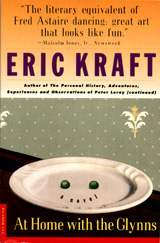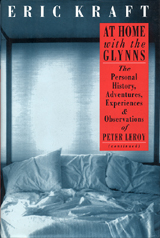
YOU CAN READ
THE FIRST HALF OF
THE BOOK
(21 CHAPTERS)
HERE,
ONLINE,
OR,
FOR MAXIMUM PORTABILITY
AND CONVENIENCE
WHEN READING
ON THE BEACH
OR
IN THE TUB,
YOU CAN BUY THE
PICADOR USA
PAPERBACK EDITION AT
AMAZON.COM
OR
BARNES&NOBLE.COM
OR
YOU CAN DOWNLOAD
THE COMPLETE TEXT
AS AN
eBOOK
AND
READ IT ON A PDA.

|
Chapter 8
I Discover What I Want to Be When I Grow Up
 ECALLING,
NOW, the stories told about the Glynns then, I think I hear, with my adult’s
ear, a tone that I’m certain I never noticed as a boy. The tales
of the Glynns and their wacky way of life were told with the tone one might
use for a story about a particularly dense pet dog. It was, to be
technical, ridiculous. What inspired that tone might have been affection
rather than contempt, but if it was affection, then it had something in
it of the affection one feels for a pet dog, and so I guess I’d have to
conclude that there was an underlying contempt whether the tone was affectionate
or not. ECALLING,
NOW, the stories told about the Glynns then, I think I hear, with my adult’s
ear, a tone that I’m certain I never noticed as a boy. The tales
of the Glynns and their wacky way of life were told with the tone one might
use for a story about a particularly dense pet dog. It was, to be
technical, ridiculous. What inspired that tone might have been affection
rather than contempt, but if it was affection, then it had something in
it of the affection one feels for a pet dog, and so I guess I’d have to
conclude that there was an underlying contempt whether the tone was affectionate
or not.
I came home from school one afternoon not long after
my mother had told me that anecdote about the Glynns’ forgetting their
car to find her retailing it to several neighboring housewives whom she’d
assembled in a coffee-klatsch (quite probably, it occurs to me now,
so
that she could tell the story about the Glynns). She was just
finishing up when I came through the door. The women smiled and nodded
their heads as my mother spoke.
I put my books on the kitchen counter and looked
in the bread box for a snack. There was nothing but a loaf of bread.
However, on a platter on the dining room table, I saw something unfamiliar
that I recognized at once: tiny sandwiches on circular pieces of bread.
I slipped into the dining room and took two. I sat on the floor in
the corner and ate them while I watched my mother perform for her friends.
“So,” she was saying, “finally the party began breaking
up. People began leaving in little groups, making their good-byes—”
“I can never get Dick to leave a party,” Mrs. Morton
said.
My mother said, “Mm, so just as the last people
were leaving—”
“That’s Dick,” said Mrs. Morton. “Always the
last to leave.” She rolled her eyes and tapped the arm of her neighbor,
Mrs. Freed.
“So,” said my mother, “while they were standing
on the porch saying good night to the mayor and his wife—”
“Wait a minute. I’m a little confused.
Who was on the porch?” asked Mrs. Vernon. The Vernons were relative
newcomers to our block and regarded as glamorous.
“The last people to leave,” said my mother.
“Oh, that would be Dick!” said Mrs. Morton.
She laughed and tapped Mrs. Freed again.
“Well, let’s see,” said my mother, knitting her
brows. “Oh!” She brightened and went on. “While they
were saying good night to the mayor and his wife, along came Mr. and Mrs.
Glynn. Walking along—”
“Walking along, arm in arm,” said Mrs. Jerrold,
from across the street. She was a tall, slim, pretty woman with smooth
black hair. I enjoyed looking at her, but because their house was
several houses farther up the street from ours, I couldn’t see into their
windows with my binoculars.
My mother smiled and nodded, very briefly, in Mrs.
Jerrold’s direction. Mrs. Jerrold nodded back, and my mother went
on.
“Everyone stopped talking,” said my mother, spreading
her hands out as she said it, in a gesture that even I understood meant
that we—her audience—ought to stop talking, too. “The mayor must
have wondered what they were doing there—”
“Who?” whispered Mrs. Vernon, in the general direction
of Mrs. Jerrold.
“The Glynns,” whispered Mrs. Jerrold.
“He probably thought they’d decided to come back
for more champagne!” said my mother. She brought her hands together
in a single clap and swept the room with her eyes and smile.
“You remember that they left earlier?” Mrs. Jerrold
whispered to Mrs. Vernon.
“No,” whispered Mrs. Vernon, “but never mind.
It’s hard to keep people straight when you don’t really know them.”
“So,” said my mother in a louder voice, “Mayor Whitley
called out to them, ‘Did you forget something?’”
Very suddenly Mrs. Jerrold said, “And Mr. Glynn
said, ‘Yes!’” It might be more accurate to say that she squealed.
I felt a sudden panic. Was Mrs. Jerrold going to finish the story?
My mother’s eyes were wide, but nonetheless she began to giggle, just as
she had at this point in the story when she had told it to me. Everyone
else fell silent. My mother was looking at Mrs. Jerrold. For
a moment, nothing happened. Then, quite slowly, Mrs. Jerrold turned
toward the table, scanned the platter of circular sandwiches, chose one,
and took a tiny bite from it.
“‘We forgot our car!’” said my mother, nearly shouting.
We all laughed. In a while the laughter subsided,
more quickly than it had when my mother had told the story to my father
and me.
Mrs. Jerrold said, “Well, what can you expect?
He’s an abstractionist, you know.”
“Abstractionist?” said my mother. “I don’t
think that’s quite right.”
“Oh?” said Mrs. Jerrold. She nibbled at her
sandwich again. The way she pinched her lips to take the tiny bites
she was taking made her considerably less attractive.
“I thought he was a—what’s it—a symbolist,” said
Mrs. Morton.
“No, no, no,” said Mrs. Jerrold, using the same
pinched mouth she’d used to take those tiny bites. “She is the symbolist.”
My mother said, “I think my friend Dudley Beaker
says that Mr. Glynn is an exhibitionist.”
“What is a symbolist, exactly?” asked Mrs. Vernon.
Everyone except my mother, who seemed to be searching
her memory for whatever it was Dudley Beaker had told her about Andy Glynn,
turned toward Mrs. Jerrold.
“Welllll—” said Mrs. Jerrold, with a knowing smile.
“No, not an exhibitionist,” said my mother.
“That’s something else. An expressionist.”
“I know what you mean,” said Mrs. Vernon, reaching
out toward my mother. “I can never remember the difference between
Manet and Monet.”
“Or maybe it’s im-pressionist,” said my mother.
“And I can never remember the difference between
constructivism and suprematism,” said Mrs. Freed, shaking her head and
smacking herself between the eyes.
Everyone turned toward Mrs. Jerrold again.
“Welllll—” she said again, and she turned toward
the platter again, apparently because she would need another little circular
sandwich before she could explain all the ists and isms that
had been thrown her way.
I don’t recall just how Mrs. Jerrold defined
abstract
expressionist or symbolist that afternoon, but I do recall the
impressions that she left with me. I got the vague idea that abstract
expressionist meant something like “comedian” or “clown,” and that maybe
being an abstract expressionist or expressing things abstractly
had something to do with vaudeville, which was another thing that adults
referred to with the same mixture of amusement and embarrassment that Mrs.
Jerrold used for abstract expressionism. I knew that vaudeville involved
performing, too, and Mrs. Jerrold made the point—quite vividly and memorably,
waving her arms around quite a lot—that abstract expressionism was a pretty
active way of painting, involving a lot of throwing, flinging, and flicking
blobs of paint around. She was so good at miming these techniques
that we actually cringed when she flung paint in our direction, and my
mother’s face took on the same worried look that came over it at the dinner
table whenever I tried to talk and twirl spaghetti at the same time.
I got the impression that a symbolist might be someone suffering from a
disease, like a diabetic or a hemophiliac, because whenever Mrs. Jerrold
said “symbolist,” she followed it with a turning-down of the corners of
her mouth, and the rest of the group acknowledged this expression with
a sympathetic knitting of the brows, and some clucking.
I was left with one other impression from that afternoon:
that the Glynns were wonderful, that they were what I wanted to be when
I grew up. The idea that they could give themselves up so completely
to whatever was on their minds raised the possibility of my becoming everything
I seemed to be when I was dreaming.
|

|



 Here
are a couple of swell ideas from Eric Kraft's vivacious publicist, Candi
Lee Manning:
Here
are a couple of swell ideas from Eric Kraft's vivacious publicist, Candi
Lee Manning: